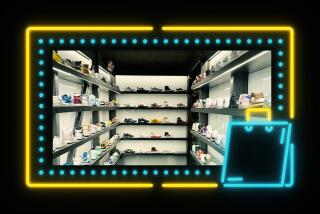These Malls Have More to Sell Than Just Shoes : Trends: Offering everything from ice rinks and lakes to dolphin shows and robots, shopping centers across America are turning into travel destinations.
- Share via
There was a time when people only went to shopping malls to shop. Nowadays, however, many malls around the country are being designed to also serve as sightseeing attractions and travel destinations.
Some of these malls are billed as “festival marketplaces” due to the number of events and attractions scheduled. They appeal to visitors beyond their own area.
“Malls have become more specialized, and some are places where you can spend a lot of time without necessarily shopping,” said Don Pendley, a spokesman for the New York-based International Council of Shopping Centers. “Sightseeing and entertainment factors are used to draw and hold people. Theme parks and amusement centers were always part of malls in Canada, and this concept has been catching on in the U.S. as well.”
“There’s no question that the marriage of sightseeing and entertainment with shopping is going to be repeated in the future,” said Billie Scott, a spokeswoman for Melvin Simon & Associates, an Indianapolis-based company that develops and manages shopping malls.
In Edmonton, Canada, the West Edmonton Mall encompasses an incredible 5.2 million square feet. That translates, roughly, to about 48 city blocks or 115 U.S. football fields. Besides some 800 shops, the complex includes an ice-skating rink, chapel, aviary, aquarium, water park, submarine rides, a dolphin show and wild animals, including monkeys and Siberian tiger cubs.
A bit less lavishly, the Woodbine Center in Toronto includes a one-acre indoor theme park, complete with skylights and climate controls, all spread over 895,000 square feet. The center, which opened in 1985, has been averaging about 6 million visitors a year.
“The amusement park does attract travelers who might not otherwise come to use our shops and services,” said Michelle Welter, a Woodbine spokeswoman.
The newest of these mini-destinations in the United States is the Mall of America in Bloomington, Minn., a suburb of the Twin Cities. Scheduled to open Aug. 11, the four-level complex will feature, among other highlights: Underwater World, a 1.2-million-gallon walk-through aquarium; a Lego Imagination Center with more than 30 large-scale Lego models as well as play areas; and Golf Mountain, which will have two high-tech miniature golf courses. A seven-acre Knott’s Camp Snoopy family amusement park is scheduled to open on the grounds next spring.
An “Upper East Side” nightclub district will offer night life as well as comedy clubs, karaoke bars and country and Western taverns--all part of the mix designed to make the Mall of America a one-stop leisure and recreational center. More conventional offerings include the 14 movie theaters, 400 specialty shops and four major department stores.
The mall is also climate-controlled (70 degrees), with the entire area covered by either roofs or skylights. A tram system runs through the third level.
“This is a tourist attraction as well as a place to shop, and we expect to draw 30% of our traffic from 150 miles outside of the mall,” said Colleen Hayes, a mall spokeswoman. “We already have over 1,000 motor-coach tours booked for visits in 1992 alone.”
Present plans call for at least two hotels offering about 1,000 rooms to be built by the mid-1990s.
The Forest Fair Mall north of Cincinnati, which opened in March of 1989, is a smaller-scale example. Among the features are an entertainment/amusement area called Time Out, and a stage-performance area that seats 1,600.
“This type of super-regional mall has a strong attraction for out-of-state visitors, especially for the entertainment, as shopping becomes of secondary value,” said Dave Madison, manager of Forest Fair.
Pier 39 in San Francisco has a waterfront park, street performers, multimedia theater, carousel, game arcade and a marina for visiting vessels, in addition to about 110 stores. It also serves as the starting point for day cruises of the harbor and a cable car tour of the city. The most unusual feature, however, are the 300 to 600 sea lions that have taken up residence year-round next to the pier. Visitors can see the seals from only a few feet away. Coming up in late 1993 is an “Underwater World” sightseeing attraction.
“We consider ourselves a festival marketplace as well as a shopping mall,” said Alicia Vargas, a Pier 39 spokeswoman. “We host about 10.5 million visitors a year, with about 60% of this total being tourists. There are so many things to do here that it’s hard to say how many people actually shop.”
Some malls use cultural offerings to attract visitors. For example, the Foothills Mall in Tucson, Ariz., includes the Old Pueblo Museum, which features exhibits on the American Southwest as well as audiovisual theater and subterranean galleries with a rare mineral display. Another mall attraction is a miniature toy train museum.
“Many people come to see the museum and not necessarily to shop,” said Gloria Bloomer, a spokeswoman for the mall. “About 20%-25% of our visitors come from outside the Tucson area.”
Sawgrass Mills, a discount shopping mall about nine miles from Ft. Lauderdale, Fla., offers visitors a man-made lake with animated alligators and flamingos who talk to each other, spread over 2.2 million square feet. Other attractions include a Video Court, with two giant video walls, each composed of 16 monitors.
The center, which opened two years ago and drew 13 million visitors in 1991, its first full year of operation, also offers occasional live entertainment and special events. Shuttles, costing $4 each way, run from both Ft. Lauderdale and Miami Beach to the mall.
Harbourplace in Baltimore includes an aquarium, Science Center, Maritime Museum and the top of the World Observation Tower among its shopping pavilions. Street performers and special theater shows offer a variety of entertainment.
River Falls Mall in Clarksville, Ind., about four miles across the Ohio River near Louisville, has the River Fair amusement park, with its robotic, storytelling Mark Twain and performances by robotic animals, including a singing group of five tropical birds. A period-piece train takes visitors around the park.
Scheduled to open for business Monday, the Forum Shops at Caesars Palace will encompass 240,000 square feet on the strip in Las Vegas, and feature an enclosed re-creation of a Roman street scene plus a festival fountain with animated robotic versions of Roman gods accompanied by lasers, music and sound effects. A painted sky will cover the barrel-vaulted ceiling.
“We anticipate that about 75% of the Forum traffic will be tourists,” said Scott of Melvin Simon & Associates, which is developing the project.
Other malls around the country that cater to tourists as well as locals include Faneuil Hall and Marketplace Center in Boston, South Street Seaport in New York City, the Jackson Brewery in New Orleans, Union Station in Indianapolis, Bayside Marketplace in Miami, St. Louis Union Station, and Settler’s Green in North Conway, N.H.
More to Read
Sign up for The Wild
We’ll help you find the best places to hike, bike and run, as well as the perfect silent spots for meditation and yoga.
You may occasionally receive promotional content from the Los Angeles Times.






